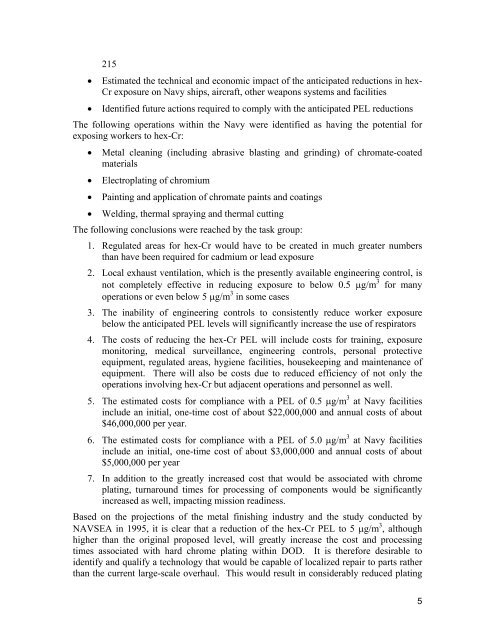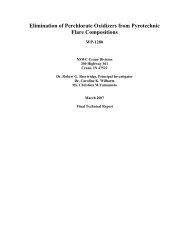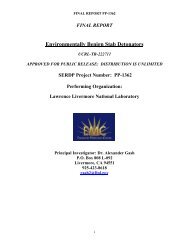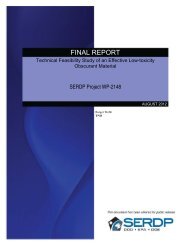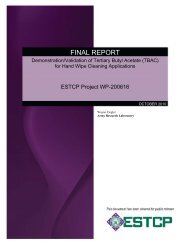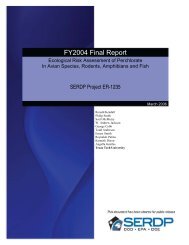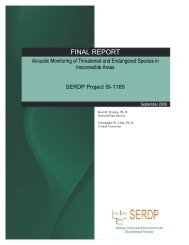Final Report - Strategic Environmental Research and Development ...
Final Report - Strategic Environmental Research and Development ...
Final Report - Strategic Environmental Research and Development ...
You also want an ePaper? Increase the reach of your titles
YUMPU automatically turns print PDFs into web optimized ePapers that Google loves.
215<br />
• Estimated the technical <strong>and</strong> economic impact of the anticipated reductions in hex-<br />
Cr exposure on Navy ships, aircraft, other weapons systems <strong>and</strong> facilities<br />
• Identified future actions required to comply with the anticipated PEL reductions<br />
The following operations within the Navy were identified as having the potential for<br />
exposing workers to hex-Cr:<br />
• Metal cleaning (including abrasive blasting <strong>and</strong> grinding) of chromate-coated<br />
materials<br />
• Electroplating of chromium<br />
• Painting <strong>and</strong> application of chromate paints <strong>and</strong> coatings<br />
• Welding, thermal spraying <strong>and</strong> thermal cutting<br />
The following conclusions were reached by the task group:<br />
1. Regulated areas for hex-Cr would have to be created in much greater numbers<br />
than have been required for cadmium or lead exposure<br />
2. Local exhaust ventilation, which is the presently available engineering control, is<br />
not completely effective in reducing exposure to below 0.5 µg/m 3 for many<br />
operations or even below 5 µg/m 3 in some cases<br />
3. The inability of engineering controls to consistently reduce worker exposure<br />
below the anticipated PEL levels will significantly increase the use of respirators<br />
4. The costs of reducing the hex-Cr PEL will include costs for training, exposure<br />
monitoring, medical surveillance, engineering controls, personal protective<br />
equipment, regulated areas, hygiene facilities, housekeeping <strong>and</strong> maintenance of<br />
equipment. There will also be costs due to reduced efficiency of not only the<br />
operations involving hex-Cr but adjacent operations <strong>and</strong> personnel as well.<br />
5. The estimated costs for compliance with a PEL of 0.5 µg/m 3 at Navy facilities<br />
include an initial, one-time cost of about $22,000,000 <strong>and</strong> annual costs of about<br />
$46,000,000 per year.<br />
6. The estimated costs for compliance with a PEL of 5.0 µg/m 3 at Navy facilities<br />
include an initial, one-time cost of about $3,000,000 <strong>and</strong> annual costs of about<br />
$5,000,000 per year<br />
7. In addition to the greatly increased cost that would be associated with chrome<br />
plating, turnaround times for processing of components would be significantly<br />
increased as well, impacting mission readiness.<br />
Based on the projections of the metal finishing industry <strong>and</strong> the study conducted by<br />
NAVSEA in 1995, it is clear that a reduction of the hex-Cr PEL to 5 µg/m 3 , although<br />
higher than the original proposed level, will greatly increase the cost <strong>and</strong> processing<br />
times associated with hard chrome plating within DOD. It is therefore desirable to<br />
identify <strong>and</strong> qualify a technology that would be capable of localized repair to parts rather<br />
than the current large-scale overhaul. This would result in considerably reduced plating<br />
5


